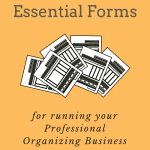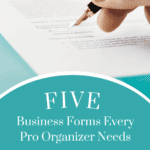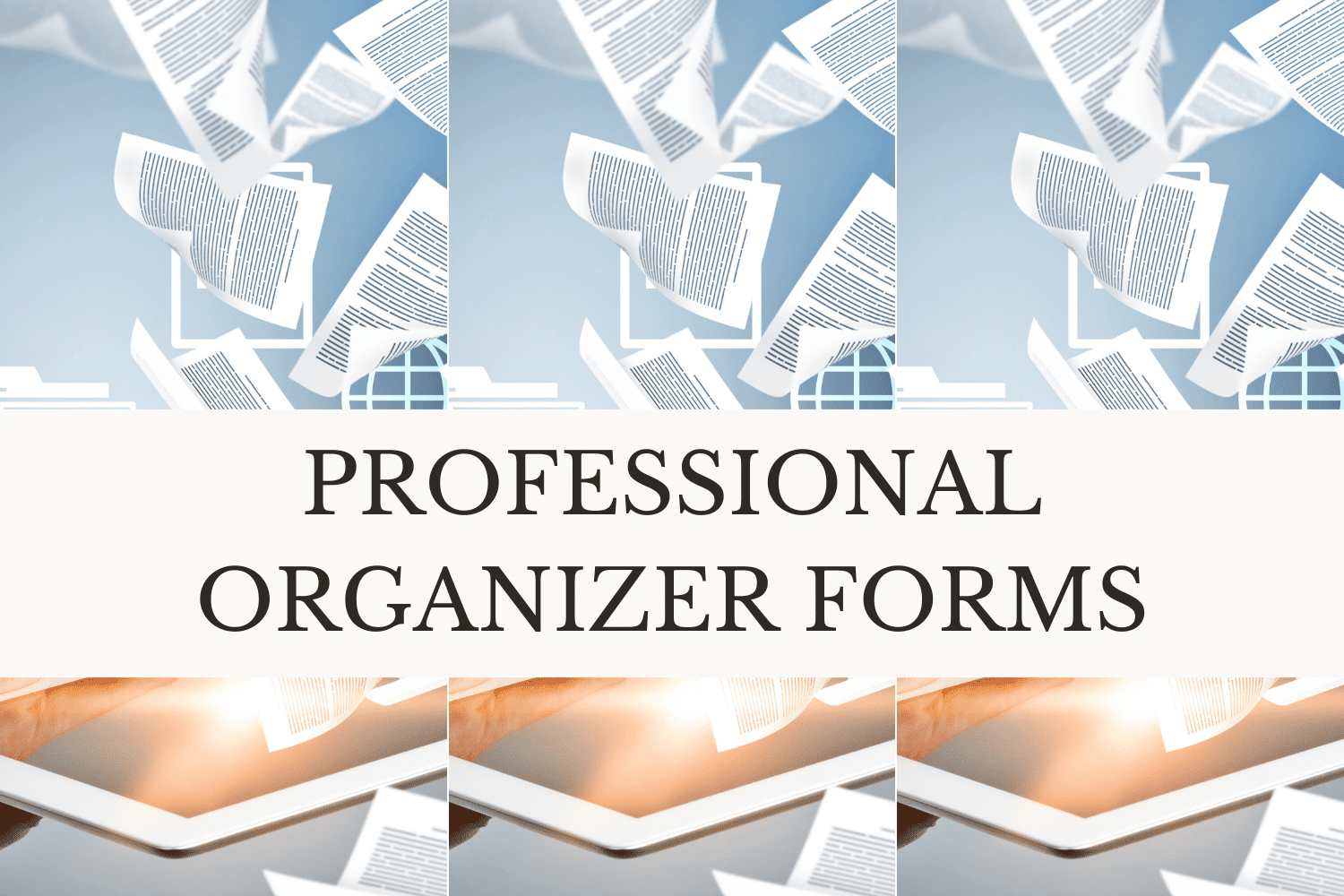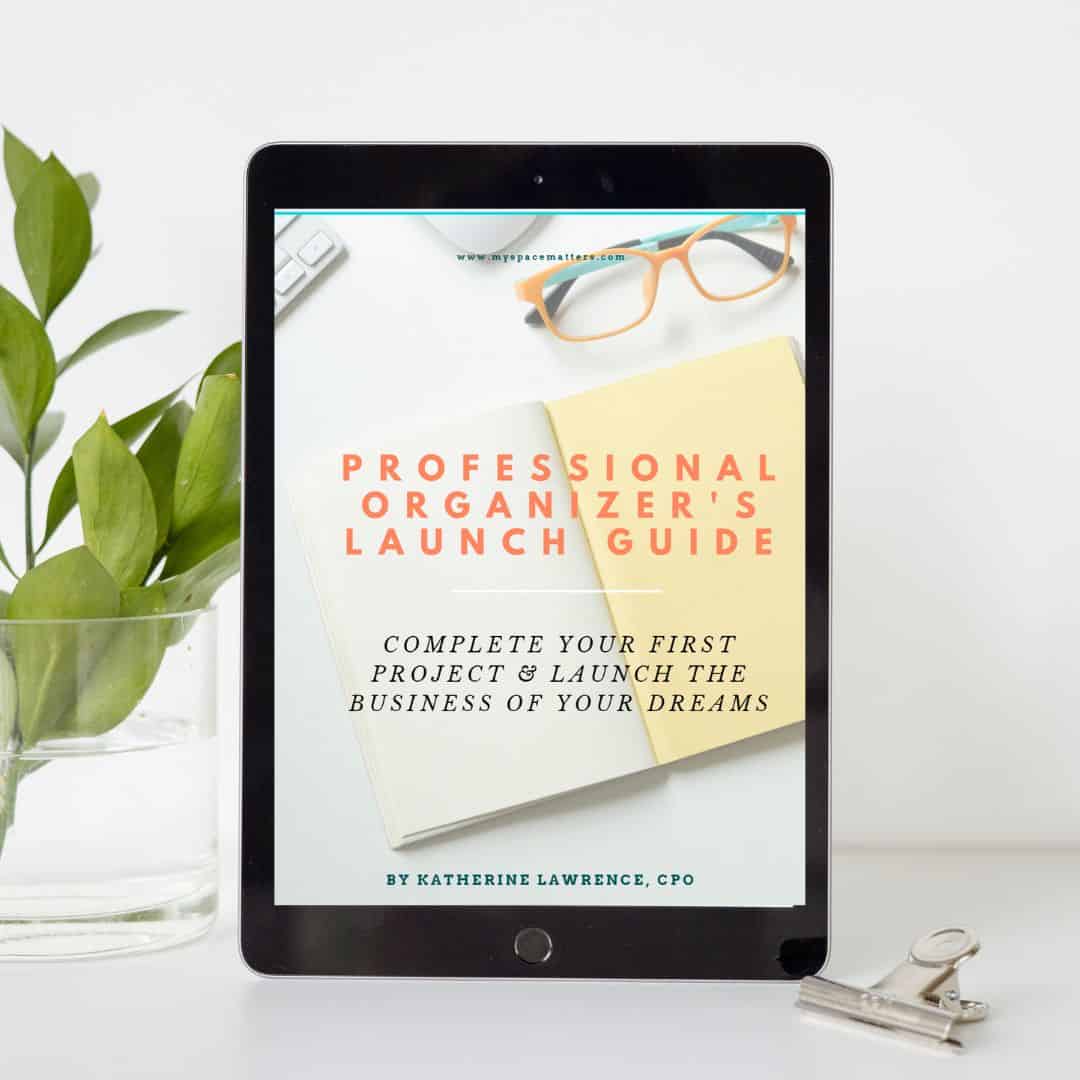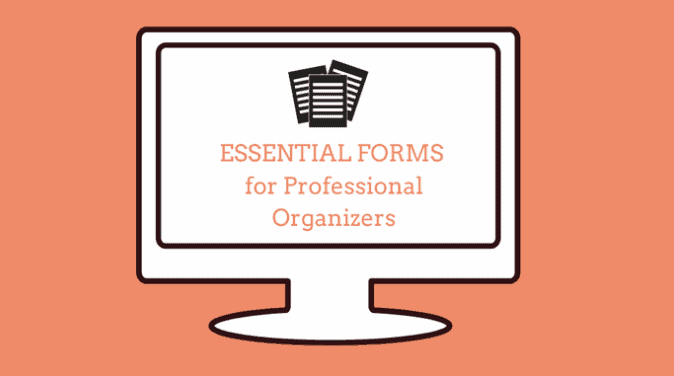5 Professional Organizing Forms Essential to Your Home Organizing Business
This post dives into the indispensable professional organizer forms that streamline operations and enhance client relations, drawing from my own extensive experience in the field.
Through trial and error, I’ve honed in on the documents that truly make a difference in managing a thriving organizing business. Sharing these insights is my way of helping you bypass common hurdles and fast-track your success.
This post is all about professional organizer forms, crafted to set you up for success from the get-go.
Forms for Your Pro Organizing Business
When I first started organizing for clients, I quickly discovered that I needed forms that would help me keep my clients, tasks, and business organized.
The professional organizing forms I use most often in my home organizing business are:
- Client Intake Form & Questionnaire
- Client Agreement
- Project Planning Forms
- Contractor Agreements
- Testimonial Request Form

1. Client Intake Form & Questionnaire
One of the cornerstones of any organizing business is the Client Intake Form. However, I’ve learned through experience that handing over a form for clients to fill out can be less effective. Many times, clients won’t complete the forms on their own. That’s why I’ve adopted a more interactive approach.
During an initial phone consultation, I use a Client Intake Questionnaire as a guide to ask all the right questions. This not only ensures I don’t miss out on any vital information but also helps in building a rapport with the client from the get-go. We discuss their goals, the scope of the project, and any specific needs or concerns they might have. This personalized touch sets the tone for a trusting and collaborative relationship.
The Client Intake Questionnaire and Client Intake Form are both professional organizer PDFs in the Essential Forms Course for Professional Organizers.
{Related Posts: Name Your Organizing Business | Category Become a Professional Organizer}
2. Client Agreement
The Client Agreement form is the backbone of the professional relationship you establish with your clients. This document clearly outlines the services you provide, the fees involved, payment terms, and any other critical details that protect both you and your client. It’s a mutual understanding put down on paper, ensuring transparency and setting clear expectations. This is a good place to put in a photo release if you plan to use photos from your client’s homes in marketing materials like social media posts.
In my course, I provide a customizable Client Agreement template that covers all the essential bases, including clauses like a photo release, which are crucial for your marketing efforts. Remember, a well-drafted agreement is a hallmark of professionalism and instills confidence in your clients about your business practices.

3. Project Planning Forms
An Action Plan is your strategic roadmap for each organizing project. It details the targeted areas for organization, outlines the tasks at hand, sets achievable goals with your clients, and lists the necessary supplies and resources.
I used to do my client planning using a paper form but then I switched from paper planning to digital planning using a project management tool called Trello. It’s free to use the basic features and you can easily share a copy with your client that they can view from their smartphone or tablet. This has revolutionized how I manage these plans, offering flexibility and real-time updates to both me and my clients.
In my Client Planning course, I delve into how to effectively create and manage action plans, ensuring you’re always prepared and on track. Whether you prefer digital tools or traditional methods, having a solid action plan in place is key to a successful organizing project.
Get your editable paper planning forms HERE or plan out client projects on your phone or tablet with Trello.
4. Contractor/Employer Agreements
As your business grows, you might find the need to bring in additional help. Contractor/Employee Agreements are vital in defining the relationship between you and any external help you employ. These documents ensure that everyone involved understands their roles, responsibilities, and the terms of their engagement with your business.
Protecting your business with clauses like anti-solicitation and confidentiality is crucial. Always check with your attorney since legalities change from state to state. Establishing a clear, professional relationship with your team members from the outset is essential for maintaining the high standards of your service.

5. Testimonial Request Form: Amplifying Client Satisfaction
The power of a positive testimonial cannot be overstated in the organizing business. The Testimonial Request Form is a structured way to capture your clients’ feedback and experiences. This not only serves as a fantastic tool for your marketing efforts but also provides invaluable insights into how you can further refine and improve your services.
With just a few simple questions like –
- Why did you choose my business?
- How has working with me made a difference?
- What would you tell a friend about getting organized with my services?
In my course, Essential Forms for Professional Organizers, I provide guidance on how to effectively use these forms to enhance your business’s reputation and client satisfaction. Encouraging clients to share their success stories can significantly boost your credibility and attract new business.
When you buy something we recommend, we may get an affiliate commission — but it never affects your price or what we pick.
This post was about the Professional Organizing forms you’ll need for your business.
By adopting these essential documents, you can elevate the professionalism and efficiency of your organizing services. Remember, the right forms not only simplify your workflow but also contribute significantly to your business’s success and growth.

